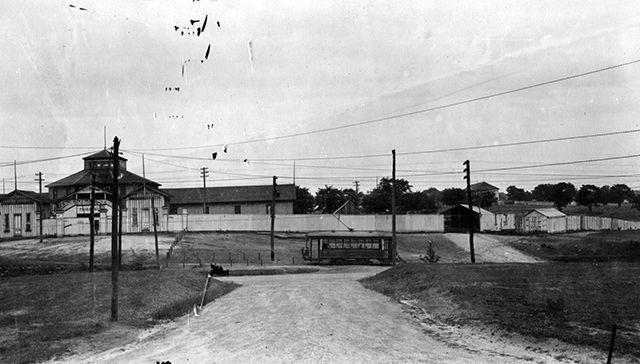 This photo was taken in 1910, when the fairgrounds were at its second location next to the railroad and across from Patterson Hall on Hillsborough Street. The fair was located here from 1973 until 1925, when it moved to its current location in 1928." />
This photo was taken in 1910, when the fairgrounds were at its second location next to the railroad and across from Patterson Hall on Hillsborough Street. The fair was located here from 1973 until 1925, when it moved to its current location in 1928." />
Source: NCSU Libraries
This photo was taken in 1910, when the fairgrounds were at its second location next to the railroad and across from Patterson Hall on Hillsborough Street. The fair was located here from 1973 until 1925, when it moved to its current location in 1928.
From fried foods, to thrilling rides, to enormous produce, the annual North Carolina State Fair is undoubtedly an exciting experience. The fair has been around for more than 160 years, and for many, it is considered a holiday. Preparation for the fair is perpetual, according to Wesley Wyatt, a 1979 NC State alumnus and North Carolina State Fair manager.
“It’s a year-round job with the events we have and planning for the fair and capital projects,” Wyatt said.
One of the constant influences of the fair is agriculture. In fact, the fair emerged as an opportunity to improve farming practices and teach scientific agricultural methods in North Carolina, according to NCpedia. In 1852, John F. Tompkins, an agricultural journal editor, organized a Raleigh meeting of the agricultural reform advocates. It was at this meeting they re-introduced the North Carolina State agricultural society and decided an annual state fair was the best way to enhance farming methods.
Throughout the years, the State Fair has taken place in three different sites, one of which is in close proximity to where NC State is located today. The fair originally took place on a 16-acre lot one mile east of the Raleigh Capitol October 1853. However, during the 1860s, the Civil War brought the State Fair to a close, with Confederate soldiers using the fairgrounds for the instruction of volunteer troops. Finally, in 1869, four years after the end of the war, the former leaders revived the fair. Then, in 1873, the fair moved to a more spacious site next to the North Carolina Railroad, across from Hillsborough Street and present-day NC State campus.
The fair primarily focused on crops, livestock, agricultural findings and household items. It presented various exhibits from the North Carolina Department of Agriculture and the North Carolina College of Agriculture and Mechanic Arts (known as the NC College of Agriculture and Engineering after 1917). However, it was in this new location that amusements on the modern midway were implemented. Featuring thrilling attractions, freak shows, games, concessions and rides, the turn of the 20th century established quality entertainment. The fair settled in this location until 1925.
The North Carolina State Agricultural Society faced adversity when the audit report proved it could not continue the fair under private ownership due to debt and mediocre fair revenues. Shortly after, the Society sold its fairgrounds and facilities to cover the debt. Consequently, there was no fair in 1926 or 1927.
Fortunately, the state acquired the fair in 1928. If it hadn’t, the fair likely would not have survived. The Society had inadequate funds and the subsequent stock market crash in 1929 would likely have resulted in its demise. The timing was perfect.
In 1928, the fair opened on new grounds (its current location) under state responsibility of the Department of Agriculture.
George Hamid, owner of a circus and Atlantic City’s Million Dollar Pier, supplied carnival acts for performances from 1929 into the 1960s. The James E. Strates Shows also supplied midway shows and rides for a number of years.
In 1937, J. Sibley Dorton became the first manager of the fair and held its status until Dorton’s death in 1961. Dorton was a visionary; he dreamed of a place that could serve North Carolinians year-round for multiple purposes. The Dorton Arena was built in 1951 in hopes to achieve this goal, and it also shaped the modern fair.
Since 1853, the event has flourished and continues to draws in numerous talents. The fair has hosted former presidents Franklin D. Roosevelt, Theodore Roosevelt, Harry Truman, Gerald Ford and George H.W. Bush.
Although it has grown exponentially from its initial debut, the fair remains an honorable gift to its agricultural roots and North Carolina culture.
“I moved to Raleigh in 1969 and have attended the fair since then,” Wyatt said. “I’ve always loved the atmosphere of being in the autumn crisp air, the colors and overall excitement.”
Wyatt said his favorite parts of the fair are the variety, competitive exhibits, food and the carnival.
“Of course, I like the Howling Cow ice cream,” Wyatt said.